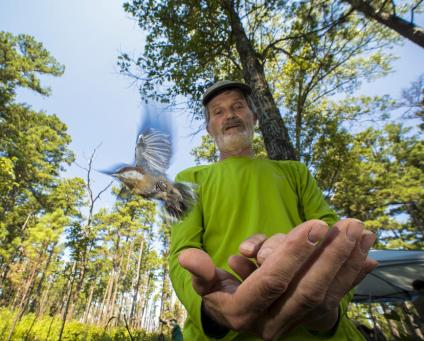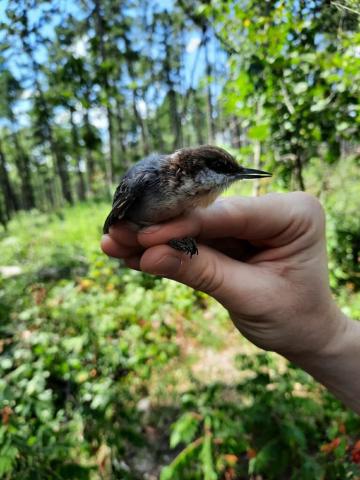Forest restoration effort culminates in return of long-absent brown-headed nuthatch
MISSOURI—It weighs in at one-third of an ounce, approximately the same as the combined weight of a nickel and a quarter, but the return of the brown-headed nuthatch to Missouri was nevertheless a weighty event.
In early September, a collaborative forest restoration project culminated with the release of 25 brown-headed nuthatches in restored pine woodlands on the Mark Twain National Forest, marking the bird’s return to Missouri after being locally extinct for more than a century.
Approximately 6 million acres of shortleaf pine and oak woodland once covered Missouri’s Ozarks; today, that ecosystem covers closer to 100,000 acres. Work by the Mark Twain National Forest to restore shortleaf pine and oak woodland accelerated in 2012, when the forest and partners were selected for the Collaborative Forest Landscape Restoration Program. The CFLRP engages state, federal and private partners in restoring woodlands on multiple ownerships in the state.
The CFLRP included 100,000 acres on the Eleven Point and Poplar Bluff ranger districts of the forest as priority landscapes for restoration. Missouri’s restoration is part of a roughly 1-million-acre natural communities restoration target for Missouri, Arkansas and Oklahoma on public lands.The Mark Twain National Forest site was chosen for the release because it is the largest area of open pine woodlands in the state.
Today, there is sufficient pine habitat to support a population of brown-headed nuthatches in Missouri. However, a team led by Frank Thompson, a research wildlife biologist with the Northern Research Station in Columbia, Sarah Kendrick (Missouri Department of Conservation) and Tom Bonnot (University of Missouri) determined that the birds were not likely to return on their own because of distance and habitat fragmentation.
Instead, the birds would need a helping hand. Thompson, Kendrick and Bonnot coordinated with state and federal partners in both Arkansas and Missouri, as well as consulting brown-headed nuthatch expert Jim Cox from Tall Timbers Research Station, to capture nuthatches on the Ouachita National Forest in Arkansas, where populations are robust enough to supply them.
he birds were flown to Missouri and released on the Mark Twain, a site chosen because it is home to the state’s largest area of open pine woodlands. Half of the birds are tagged with tiny radio-transmitters that allow scientists to track their movements.
“So far the tagged birds are moving around exploring the woodlands and socializing in small groups as we would expect them to. All indications are they are doing great,” Thompson said.
Fifty birds were released in late August and early September; and the team plans to release another 50 birds next year.
“This project demonstrates the power of shared stewardship,” said Sherri Schwenke, forest supervisor on the Mark Twain. “It took all of our expertise to bring the brown-headed nuthatch home, just as it takes all of us to accomplish everything we do in terms of restoration, recreation and timber.”


